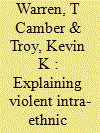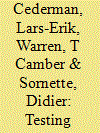|
|
|
Sort Order |
|
|
|
Items / Page
|
|
|
|
|
|
|
| Srl | Item |
| 1 |
ID:
138077


|
|
|
|
|
| Summary/Abstract |
Despite significant advances in the disaggregation of the study of civil conflict and intraethnic violence, intra-ethnic violence remains understudied. In this article, we present the first systematic, cross-national analysis of the conditions that promote violent, fragmentary conflict within politically active ethnic minorities. We propose a model of intra-ethnic conflict in which collective violence is produced by the interaction between subgroup entrepreneurs and the suppressive actions of the state. This two-level model predicts a curvilinear relationship between the relative size of an ethnic minority and its probability of experiencing large-scale intra-ethnic conflict. Additional hypotheses based on the proposed causal mechanism are also posited. These hypotheses are tested with data drawn from a global sample of politically active ethnic minorities, for the period 1990 through 2006, using a combination of parametric and semi-parametric regression techniques. The results strongly confirm the predicted curvilinear relationship while also demonstrating that the specific shape of this relationship shifts in predictable ways under varying social and political contexts.
|
|
|
|
|
|
|
|
|
|
|
|
|
|
|
|
| 2 |
ID:
101688


|
|
|
|
|
| Publication |
2010.
|
| Summary/Abstract |
In this article, it is argued that interstate alliances function as public costly signals of state intentions to cooperate militarily, and as such, they should be expected to influence state expectations within dyads, between dyads, and across time. Accurate statistical modeling of interstate military alliances thus requires that researchers escape the assumption of independent units of observation, which is built into most of the statistical tools currently used by international relations scholars, as such models can be expected to produce unbiased parameter estimates in this domain only if the decisions to create and dissolve interstate alliances are formulated in isolated dyadic bubbles. The use of stochastic actor-oriented models, combined with Markov simulations of network evolution, is shown to be a productive alternative method of modeling interstate alliances, which allows the researcher to avoid the assumption of dyadic independence by incorporating theory-driven assumptions about patterns of extra-dyadic interdependence directly into the functional form of the statistical model. The results demonstrate that triadic patterns of amity and enmity exercise powerful influence over the selection of alliance partners and the evolution of the global alliance network. The results also show that failure to incorporate patterns of extra-dyadic interdependence into our statistical models of interstate alliance decisions is likely to result in biased parameter estimates.
|
|
|
|
|
|
|
|
|
|
|
|
|
|
|
|
| 3 |
ID:
145699


|
|
|
|
|
| Summary/Abstract |
While much previous research has examined the relationship between interstate military alliances and the structure of domestic regimes, existing findings point in contradictory directions. Some have argued that democracies attract each other as alliance partners, and thereby generate international peace as a consequence of their domestic regime type, while others have argued that the causal relationship is reversed, and that international pacification creates the necessary space for international alliances and domestic democratization. To disentangle this difficult empirical relationship, this article presents an empirically grounded simulation model of the dynamic coevolution of interstate military alliances, international conflict, and domestic democratization, demonstrating a statistical approach which accounts both for the complex interdependencies generated by coevolving multiplex networks of interstate ties and for their reciprocal influence on the coevolution of domestic political regimes, over the period 1920–2000. The results show that international institutions and domestic institutions are mutually constituted, with both ‘selection’ effects and ‘influence’ effects operating simultaneously. In particular, the evidence indicates that states with similar regimes are more prone to ally with each other, mutually democratic dyads are less inclined to engage in militarized disputes, and states that form international alliances with democratic partners are more likely to develop domestic democratic institutions. Tests of out-of-sample predictive accuracy, across multidecade prediction windows, further demonstrate that the coevolutionary model consistently outperforms specifications that ignore coevolutionary effects, in predicting subsequent patterns of military alliances, military conflict, and domestic democratization.
|
|
|
|
|
|
|
|
|
|
|
|
|
|
|
|
| 4 |
ID:
107530


|
|
|
|
|
| Publication |
2011.
|
| Summary/Abstract |
Drawing on Clausewitz's classical theory, we argue that the emergence of mass nationalism following the French Revolution profoundly altered the nature of the units constituting the interstate system, thereby transforming the conduct of interstate warfare. To validate these assertions-and thus to test Clausewitz-we rely on quantitative evidence at the macro level, with a particular focus on the global distribution of interstate war sizes, measured in terms of battle deaths, over the past five centuries. Drawing on extreme value theory, we demonstrate that temporal discontinuities in the shapes of the tails of such distributions can be used to draw inferences about the nature of the mechanisms underlying the bloodiest events in world history. This approach allows us to show that the interstate system experienced a fundamental shift in the mechanisms underlying the production of war sizes: a shift that can be dated to the years 1770-1810, and that resulted in a systematic increase in war severity. These same tools also allow us to rule out a number of alternative explanations for this shift (including changes in population sizes and changes in weapons technology), while providing evidence for a specific account of war severity rooted in the mobilizational capacities of states.
|
|
|
|
|
|
|
|
|
|
|
|
|
|
|
|
|
|
|
|
|